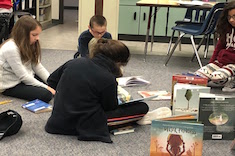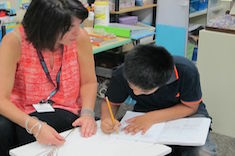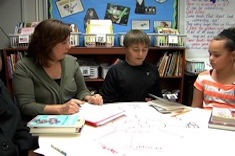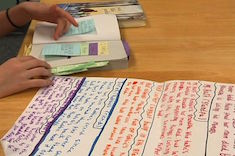My reading life is full of invitations. A friend recommends a book. I get invited into a book club. I see an announcement for the next #titletalk Twitter chat in my feed. I get an alert about a book a friend reviewed on Goodreads. All of these are invitations—things I am being invited, but not forced, to do as a reader. As a reader, I get to decide what makes sense in my reading life at any given time.
I want our classroom to be as authentic as possible for readers, so I see a big part of my role as throwing out invitations, letting readers know what is possible. I tend to give invitations by way of book talks, baskets of books around an idea, charts that invite thinking, and more.
I worry that in this age of accountability, teachers are not as comfortable throwing out invitations as we used to be. Instead, in the name of standards, every good invitation becomes an assignment or a “have-to” for our students. I know it is becoming more challenging to not make every idea in a classroom something that gives us data on a standard, but if I am committed to authentic reading workshop, then I must be committed to authentic invitations.
Tony Keefer and I have talked about this often. I tend to put out a lot of “you shoulds” to friends and family. One year I had to explain to Tony that these suggestions were not commands—they were invitations. The hashtag that was created in fun (#invitationnotcommand) has helped me really think about how comfortable I am with invitations in the classroom and whether my invitations are sometimes commands in disguise.
When I am truly genuine about invitations, I have to let go of the vision of what might happen when I put them out there. Because many of my invitations are a big flop. And I have to be okay with that. I have to be really genuine in my own belief that what I am throwing out there is an invitation and not a command. And I have to remind myself of that often.
Classroom Invitations
Late in the school year, a new book by an author we enjoyed was published. We had been talking about the things we come to expect from authors we know, and I thought this would be a great book to build on that thinking. So after reading the book aloud, I pulled the author’s other books and created a small chart with images of all three of them and added the title “Thoughts?” At the end of a minilesson I said, “If sometime this week you want to study this author’s three books together and share thoughts, here is a place to do that.”
And then . . . nothing. For a few minutes, Katie revisited one of the books, but after 10 days of nothing, I finally took the poster down. It was tempting to “reinvite” or encourage students to add something to the chart, but if I want my kids to really take ownership and have choices in their reading, then I have to let that happen naturally. If I step in and encourage, they start making the decisions they think I want them to make.
For World Read Aloud Day, we decided that our contribution would be reading to younger students. We offered whole-group, small-group, or individual read-alouds in an email sent to teachers. As requests came in, kids signed up. Of the 28 students in the classroom, 14 chose to participate. The other 14 were not interested.
After gathering all the picture books for the annual March Book Madness online event, one minilesson focused on what we believed made a compelling character. After charting that, I invited students to spend time with the books and vote weekly in the bracket. I made copies of the bracket and put the books into a basket in our meeting area. I also added sticky notes to the inside covers where students could add their thoughts for the next reader. A handful of students took me up on the invitation and participated in various ways throughout the month. The conversations were amazing, and they ended up affecting other conversations in our classroom.
I offer book clubs before school and during lunch. I offer stacks of books to students who might want to create a book club. I offer suggestions during reading conferences and put out challenges during minilessons. I hope that the variety of these invitations helps readers see all that is possible in a reading life.
If we want to keep our students’ reading lives authentic, if our goal is to support lifelong reading, then we have to think about what we mandate versus what we invite students to do. What do students really need to be accountable for? I have learned to ask myself with every idea I have, Is this something that all kids need to do for some reason, or is this something that can be a true invitation for those whose reading lives it fits right now? More often than not, I find that it can truly be an invitation.









